Planning an Iceland Camper Van Road Trip
This post may contain affiliate links.
If you’re dreaming of an Iceland camper van trip, we are sharing everything you need to know to start planning your bucket list Iceland road trip!
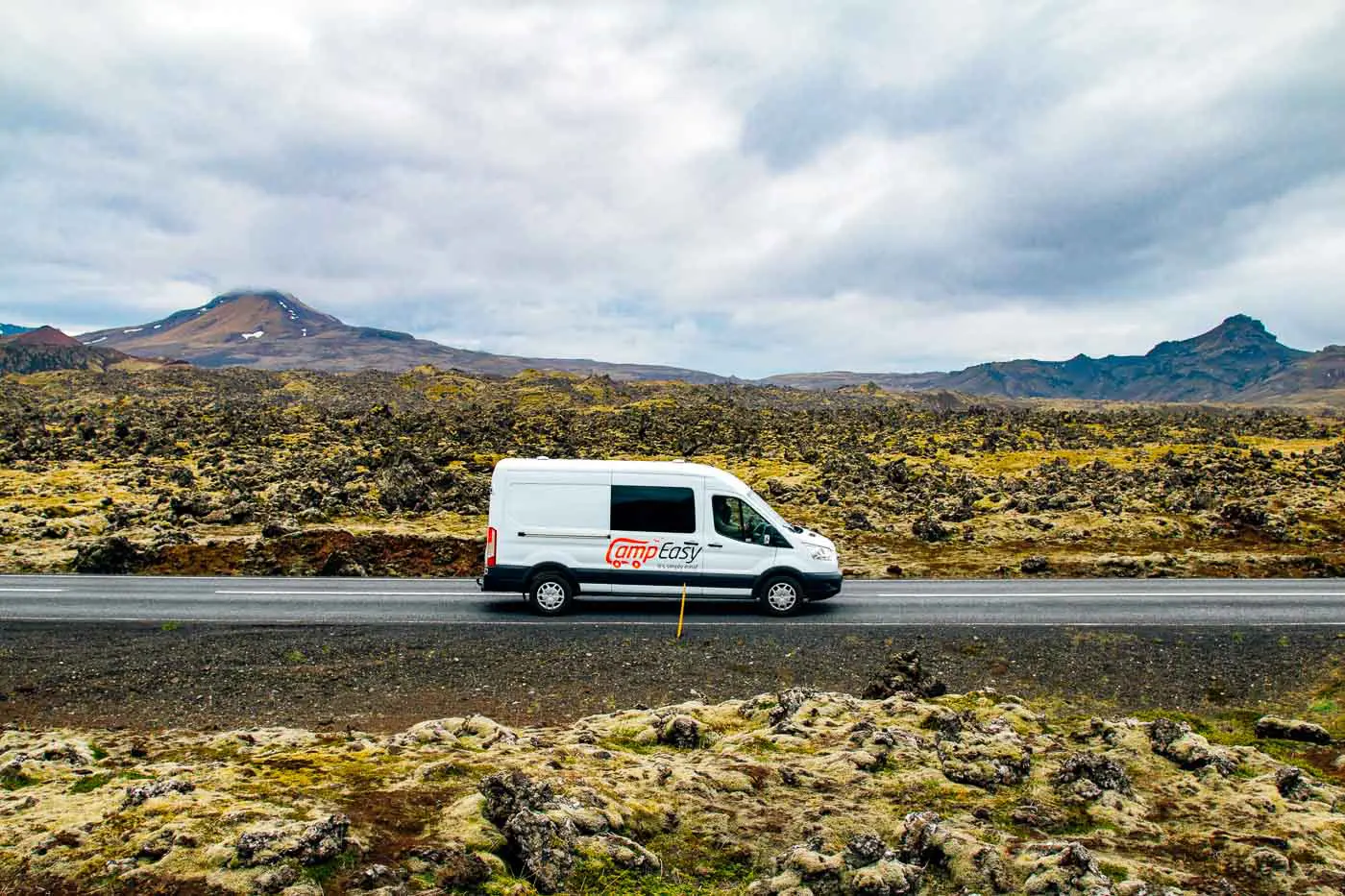
Iceland has been on our bucket list for a very long time. The spectacular waterfalls, the black sand beaches, the hulking glaciers. It’s hard to conceive of so much natural beauty all located in one place. In fact, it was kind of intimidating. There is just so much out there. Were we really ready to visit Iceland?!
We had seen thousands of photos of Iceland on Instagram before, but we also knew to fully appreciate it we had to see it with our own eyes. So when we saw some attractive airfare with a 7-day “stop-over” in Iceland, we jumped on it. We booked a campervan and started planning our ultimate Iceland road trip. Now having been, we are so happy we did. The experience was unreal.
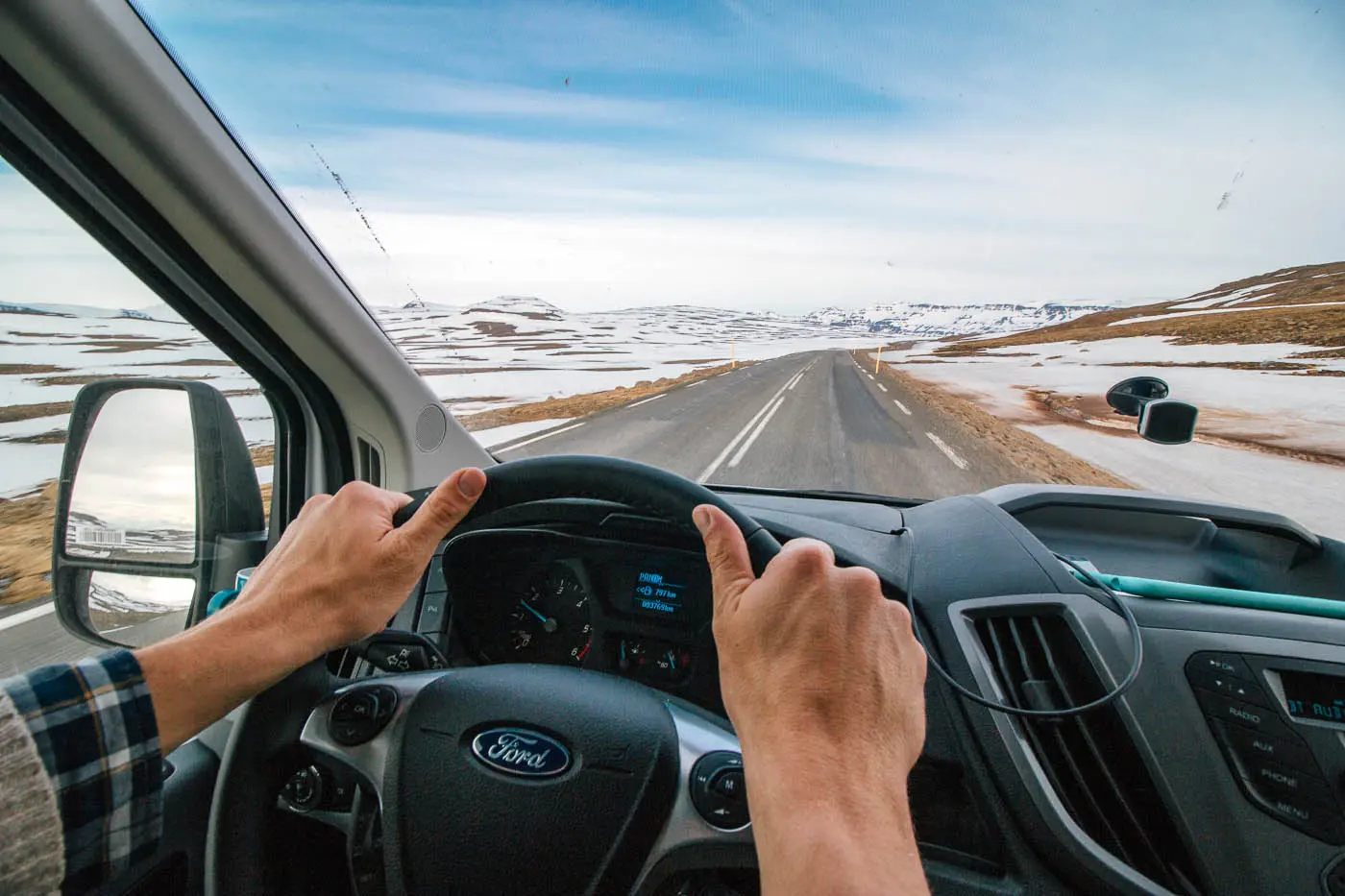
Why road trip in Iceland?
Iceland is a spectacular country, but it’s also spectacularly spread out. Large swaths of barren nothingness separate its many points of interest. And while there is a meditative calm that comes from seeing so much emptiness, it also means there is a lot of distance between locations. That is why if you want to take in the totality of Iceland’s beauty, a road trip is the best way to do it.
Iceland has very few public transportation options – especially outside of the capital city of Reykjavik, so driving is the predominant way to get around the island. While it is possible to take a bus to some of the more popular tourist destinations near Reykjavik, your options will be limited.
If you come all the way out to Iceland, then it’s worth getting behind the wheel and taking control of your adventure.
Why rent a camper van in Iceland?
There are a lot of great reasons to rent a camper van. Maybe you want to camp in some of Iceland’s incredible natural landscapes. Maybe you want to dabble in #vanlife while you’re on vacation. But for us, there is one reason that rises above all the others:
Renting a camper van affords you unparalleled flexibility when exploring the country.
You aren’t tied down to a hotel. You don’t need to find a restaurant for a meal. You don’t need to operate on anyone else’s timeline but your own. When you’re hungry, you can make yourself something to eat. When you’re tired, you can stop off at one of the hundreds of campgrounds. If you want a cup of coffee, just jump in the back and make one!
It’s a level of freedom and control you rarely get when visiting another country. Especially in a place with so much to see and so much to do, it’s nice to travel in your own little home on wheels.
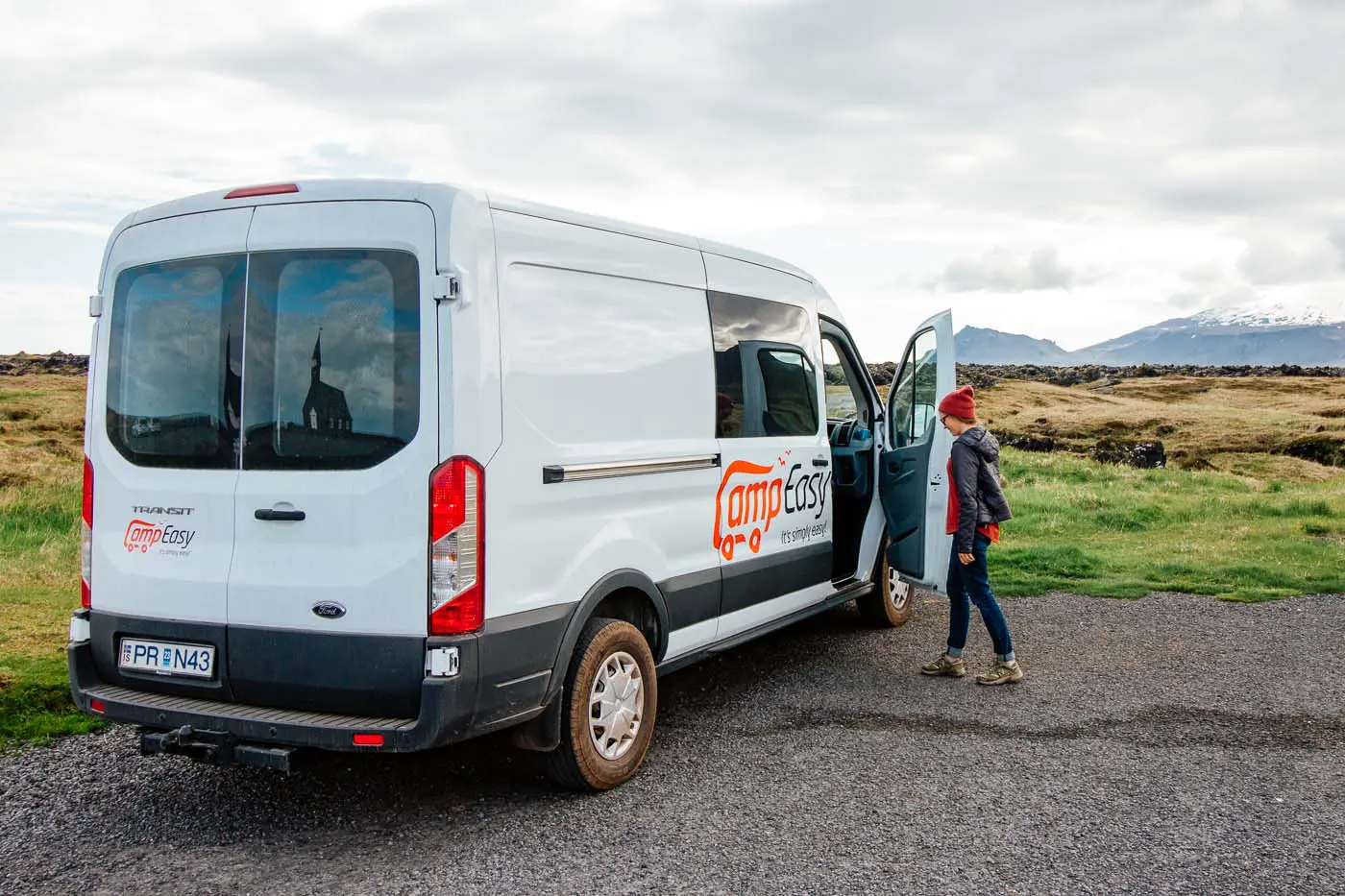
Which type of camper van is best?
There are a number of campervan rental companies in Iceland, and ultimately we went with Camp Easy. They have great reviews online and friends of ours had a good experience with them. Full disclosure, we did receive a discount from them in exchange for some photography/videography work.
If you’re traveling with 2 people, exploring Iceland for just a few days, and have minimal luggage, then one of the smaller mini-van style vans would probably be sufficient.
If you’re more than 2 people, exploring Iceland for a week or more, and have a bit of luggage, then we would definitely recommend one of the larger vans. The big difference between the larger vans is whether you want to be able to stand up inside or not.
If it’s summer and you plan to be outside most of the time, then the low roof van could be fine. Think of these vans as a heated tent that drives.
If it’s off-season and you think you might be hanging out inside the van for an extended period of time, we’d recommend getting a full-sized van. Think of this van as a mini RV.
If you are interested in exploring the highland roads that run through the interior of the country (known locally as F-roads), then you need to rent a 4×4 van. There are no 2WD vehicles allowed on these roads, so renting a 4×4 is your only option.
For our trip to Iceland, we rented the Easy Big van from Camp Easy. We decided to go with the Easy Big for a couple of reasons. 1.) It’s a Ford Transit, which is the same van we own in the states. 2.) Michael could stand up in it, which makes cooking inside a lot easier. 3.) It could accommodate all our camera gear.
What is the best time of year to visit Iceland?
The best time to visit Iceland depends entirely on what you want to do. There is no “wrong” time to visit, but when you choose to visit will have a major on the type of Iceland experience you have. For a quick reference, here are a few things to consider.
Summer
Pros: Extended daylight, puffins, whale watching, milder weather
Cons: Lots and lots of tourists
Winter
Pros: Fewer tourists, northern lights, ice tunnels
Cons: Limited daylight, colder temperatures, fewer campgrounds open
Spring/Fall
Pros: Moderate tourists, normal daylight hours, catch the best of both summer & winter
Cons: Really unpredictable weather
Long days and long nights
Midnight Sun: From May until August, it will never get completely dark at night. On the summer solstice (June 21st) in Reykjavik, the sun sets a little after midnight and rises again before 3:00 AM. This time of year is great for outdoor exploration but there is really no chance of seeing the Northern Lights.
Polar Night: From December to January, Iceland experiences very long nights and very short days. On the winter solstice (Dec 21st) in Reykjavik, the sun doesn’t rise until 11:30 AM and sets around 3:30 PM. This time of year is great for viewing the Northern Lights, but your day time outdoor exploration time will be very limited.
Normal Daylight: During March & April (Spring) and September & October (Fall), Iceland experiences what most countries would consider normal daylight hours. The best of both worlds.
Seasonal dates to know
There are some important seasonal dates to be aware of when planning a trip to Iceland, particularly if you want to explore the highlands via 4×4 using the F-road system.
F-Road Open Dates: The open date of any specific F-road can be highly weather and location dependent. Generally speaking, the F-roads begin to open no sooner than June. For more information about F-road open dates, visit Road.is to download the “Mountain Roads” brochure. This brochure is published every year by the Icelandic Road and Coastal Administration and contains approximate opening for each mountain road.
F-Roads Close Dates: The end of the season closure of a specific F-road is just as variable as its opening date. Generally speaking, F-roads will start to close in early September. Since it depends entirely on the weather conditions, there is no way to forecast when a particular F-road will close. No approximate close dates are released by the Icelandic Road and Coast Administration. Once closed, it’s closed for the season.
Campground Open Dates: There are many campgrounds that are open all year round (more than enough to handle the reduced volume of off-season campers), but there are many more that are only open seasonally. The open and close dates for each campground varies, but summer camping season is typically June 1st through August 31st. You can find a campground map here.
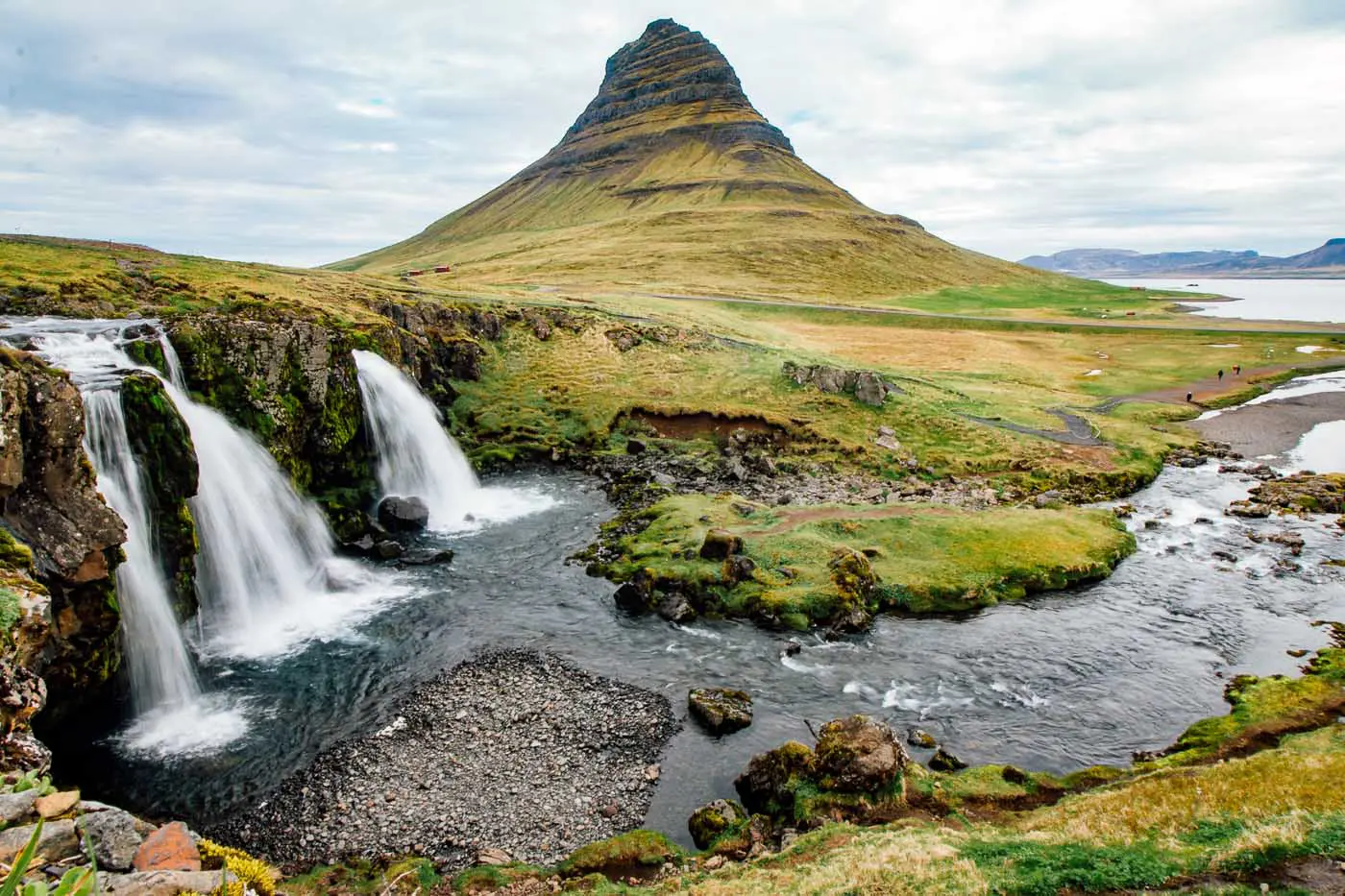
Route Planning
Next up in your planning process is coming up with an itinerary! We mapped all the spots we were interested in on a map, and then connected the dots so to speak. Here are two itineraries we put together based on our travels to help you start designing your own trip:
Driving in Iceland basics
Driver’s License: Any valid driver’s license from your home country will work in Iceland. You do not need to obtain an International Driver’s License to drive in Iceland. However, you do need to be over 21 years old to rent a vehicle in Iceland and over 23 years old to rent a 4×4 vehicle.
Insurance: When we rented our van from Camp Easy, the rental came with standard liability coverage. This is the minimum insurance required to drive on Icelandic roads. However, Camp Easy also offered a variety of enhanced add-on insurance policies, which we happily added on and would recommend others to do as well.
Speed Limits: The speed limits are very well marked in Iceland. For much of Iceland’s Ring Road, the speed limit is 90 km/h – which is a little over 55 miles an hour. This is relatively slow by US standards, but it will really give you a chance to appreciate the scenery. No matter what speed limit is posted, never drive faster than the road/weather conditions allow.
Speed Cameras: If you’re driving in Iceland you will probably encounter a speed camera at some point on your trip. They are most prevalent in and around Reykjavik, but there are some out in the more remote parts of the country as well. However, unlike America, where they try to be super sneaky and hide their speed cameras, Iceland warns you of them with a sign about a ¼ mile out. So be alert, read the sign, and make sure you’re driving the speed limit. Any speeding tickets you accrue on your trip just gets tacked on to your van rental (usually with a hefty processing fee).
One Lane Bridges: If you drive the ring road, you will encounter dozens of one lane bridges. They are very well marked, so you will know it when you see it. Don’t panic. Once you cross one, you quickly get the hang of how they work.
The general rule is the car that arrives at the entry of the bridge first has the right of way. Since there are a lot of tourists on the road, this rule is not always practiced. Often you will need to be alert and make a judgment call. Even if you arrived at the bridge entry first but the person across the way doesn’t appear to be slowing or stopping, it might be best to just let them cross. We got to witness a mid-bridge standoff, where neither party wanted to back down. Eventually, one person had to give in and reverse back the way they came. It was a waste of everyone’s time.
F-Roads: As mentioned previously, F-roads are seasonal access roads that crisscross through the highlands of Iceland. They allow you access to the interior of the country but are only passable with a 4×4 vehicle. DO NOT attempt to take a 2WD vehicle on an F-road. You will get stuck. And getting reception (much less a tow) is going to be a massive ordeal.
Toll Tunnels: There are a few toll tunnels in Iceland that cut through the mountains. These can save you quite a bit of time, but they do cost money. There are no toll booths. Entry is monitored via cameras and payment is required online within a few hours.
Weather (Wind) Forecast: Check the weather forecast – primarily for wind. The wind in Iceland can be unbelievably strong. Like rip your car door off its hinges strong. Driving in such conditions – especially in a tall van – can be extremely taxing and sometimes dangerous. So be aware of the wind forecast for the day and make plans to stop driving (or be someplace else) if the winds start to really pick up.
Currency
Iceland has its own currency called the króna, written as ISK. It is highly devalued compared to the US dollar, with one krona being worth less than one US cent. With the exception of shops within Keflavik airport (which accept USD and Euros), the króna is the only accepted currency in Iceland.
However, we did not convert any USD over to ISK during our stay in Iceland as the predominant method of payment in Iceland is by debit/credit card. Virtually every merchant, no matter how big or small, will accept debit/credit card. We paid for groceries, gas, campsites, park entry fees, all with either a credit or debit card. We never had to use cash for anything.
You will need a debit/credit card with a chip, however. Most US credit cards have switched over to the chip (versus swipe) method, so this wasn’t a problem for us.
Gas stations in Iceland
Iceland has a pretty extensive network of gas stations, but they can be few and far between in the remote parts of the country, so you will want to pay attention to your tank level. The rule of thumb we followed was if we had a ½ tank or less and we saw a gas station, we would stop to fuel up.
Don’t waste your time searching around for the best fuel prices. We do this a lot in the United States, but in Iceland we found it to be pretty hopeless exercise. The cost per liter is all pretty similar and the sparsity of gas stations means you won’t have many options.
Bring a Debit Card with a Pin Number: If you want to be able to pay-at-the-pump in Iceland, you will need a debit/credit card with an active pin number. Most US credit cards do not have a pin associated with them. Entering the zip code as the pin will not work. So your best bet is to bring along a debit card (which has a pin) to use at gas stations.
If you don’t have any card with a pin, you’re not entirely out of luck. If you arrive at a staffed gas station during business hours, you can go inside the station and pay with your credit card. The attendant will ask for a signature, but not a pin. Not all gas stations are staffed. There are many which just have pumps, so your options will be more limited.
Use the Restrooms: The availability of public bathrooms in Iceland is limited, to say the least. If you’re paying for fuel at a gas station, definitely take the opportunity of using the bathroom! This is another strong reason for smaller more frequent fuel stops.
Diesel Black Handle, Gas Green Handle: In Iceland, diesel has a black handle and gas has a green handle. In the United States, the colors are reversed. Thankfully in Iceland, they write “Gas” and “Diesel” explicitly on the handle, so there shouldn’t be any confusion. Nevertheless, I found myself instinctively reaching for the wrong handle on more than a few occasions. Just be sure you double check before you fill.
These are the names of the major gas station chains in Iceland. We stopped at all of them at some point during our journey.
N1: Perhaps the most popular gas station in Iceland, you can find N1 everywhere from large cities to tiny villages. You can pump gas here 24/7, but the store is only staffed during business hours. At the time of our van rental, Camp Easy offered us a N1 discount card.
Olís: This is the second most popular gas station we saw – after N1. They also have a sister company called OB that is run under the same management. Same as N1, you can pump gas 24/7 at Olís or OB, but the station is only staffed during business hours. If you pick up their discount card you are entitled to free WiFi and a free coffee.
Orkan: This fully automatic gas station has over 50 locations all across Iceland. You can pay-at-the-pump 24/7, but for the most part, they do not have stores associated with them. So you will be unable to pay with a credit card (without a pin) inside.
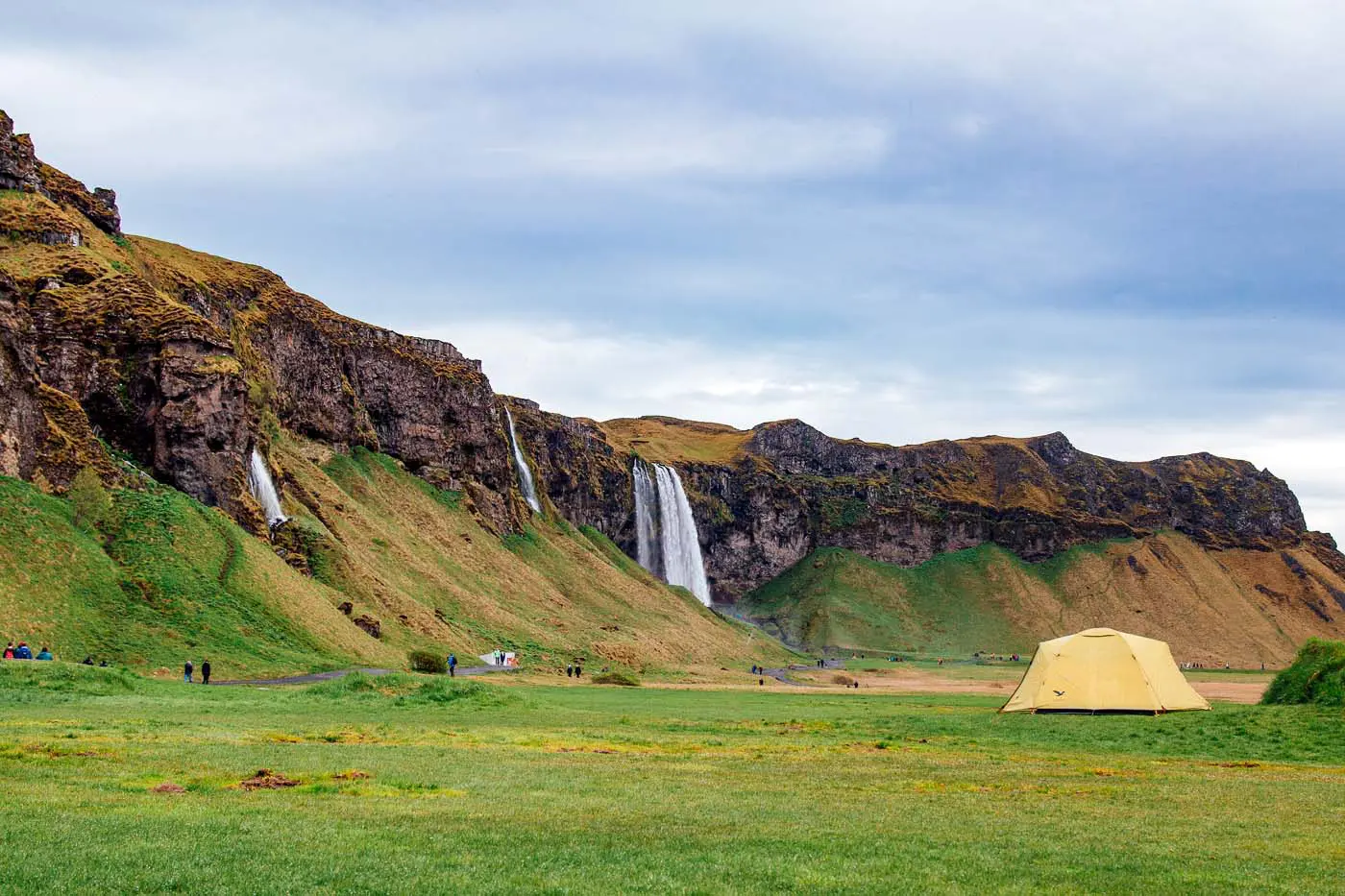
Where to camp on your Iceland road trip
Camping in Iceland is a little different than camping in the US, so it’s a good idea to do some research before you arrive. When we were preparing for our trip we found a lot of outdated information being circulated online. So we decided to compile an updated guide to camping in Iceland.
What to pack
Some items might seem obvious, but others caught us by surprise. Here is our list of what to pack for your Iceland road trip.
Layers: It doesn’t matter what time of year you travel to Iceland, pack with layers in mind. Even in summer, the weather can be unpredictable so you will want to be able to add or subtract layers to your outfit as needed.
Rain Gear: We went to Iceland in late May, which is historically the driest month of the entire year. It rained every single day. If you’re traveling to Iceland, just plan on experiencing some precipitation during your stay regardless of the time of year. Rain gear that doubles as a windbreaker is also a good idea.
*Protip – Do NOT bring an umbrella to Iceland. The wind is unbelievably strong and can kick up in an instant, making an umbrella all but useless.
Packing Cubes: When traveling in a van, it can be a real challenge to keep organized. We started using these packing cubes a few months ago and now we swear by them. Keep like clothes together. Easily find what you’re looking. Isolate dirty laundry towards the end of the trip. They are wonderful. We have no idea how we traveled without them.
Quick Drying Towel: If you want to experience Iceland’s hot springs and bathing pools, then you should definitely pack your own quick-drying towel. Towel rentals at places like the Blue Lagoon can cost a lot of money. Plus there are a ton of undeveloped hot springs that you’ll want to have a towel for.
We recommend picking up a quick-drying towel because drying things out in a van can be tricky. We bought these Nomadix towels specifically for this trip and have been happy with them.
Weatherproof Boots: No matter what the forecast says, it’s going to be wet out there. Rain, waterfall mist, ocean spray, rivers, streams. There are a lot of ways to get wet feet in Iceland. So unless you want your toes to freeze, we highly recommend comfortable weatherproof boots.
Gloves + Wool Socks + Hat: The difference between being “barely warm enough” and “comfortable warm” is having your extremities covered. Comfy wool socks, gloves, and a cap are absolute essentials in our opinion.
Sleeping Mask (summer): If you visit Iceland in the summer, the Midnight Sun can really mess with your sleep schedule. As a person who is used to rising with the sun, my already jet-lagged body had no idea when to sleep. While the curtains in the van did a decent job, using a sleep mask is the real answer. Total darkness. A rare commodity in Iceland during the summer.
Headlamp (winter): If you visit Iceland in the winter, you will be spending a lot of time in the dark, so packing along a headlamp is a smart idea. It frees up your hands and gives you directional light where you need it.
Daypack/Backpack: There are a lot of great half-day hikes all around the island. Bringing a small daypack backpack will allow you to bring some snacks, a change of clothes, and a towel (just in case you find some hot springs!).
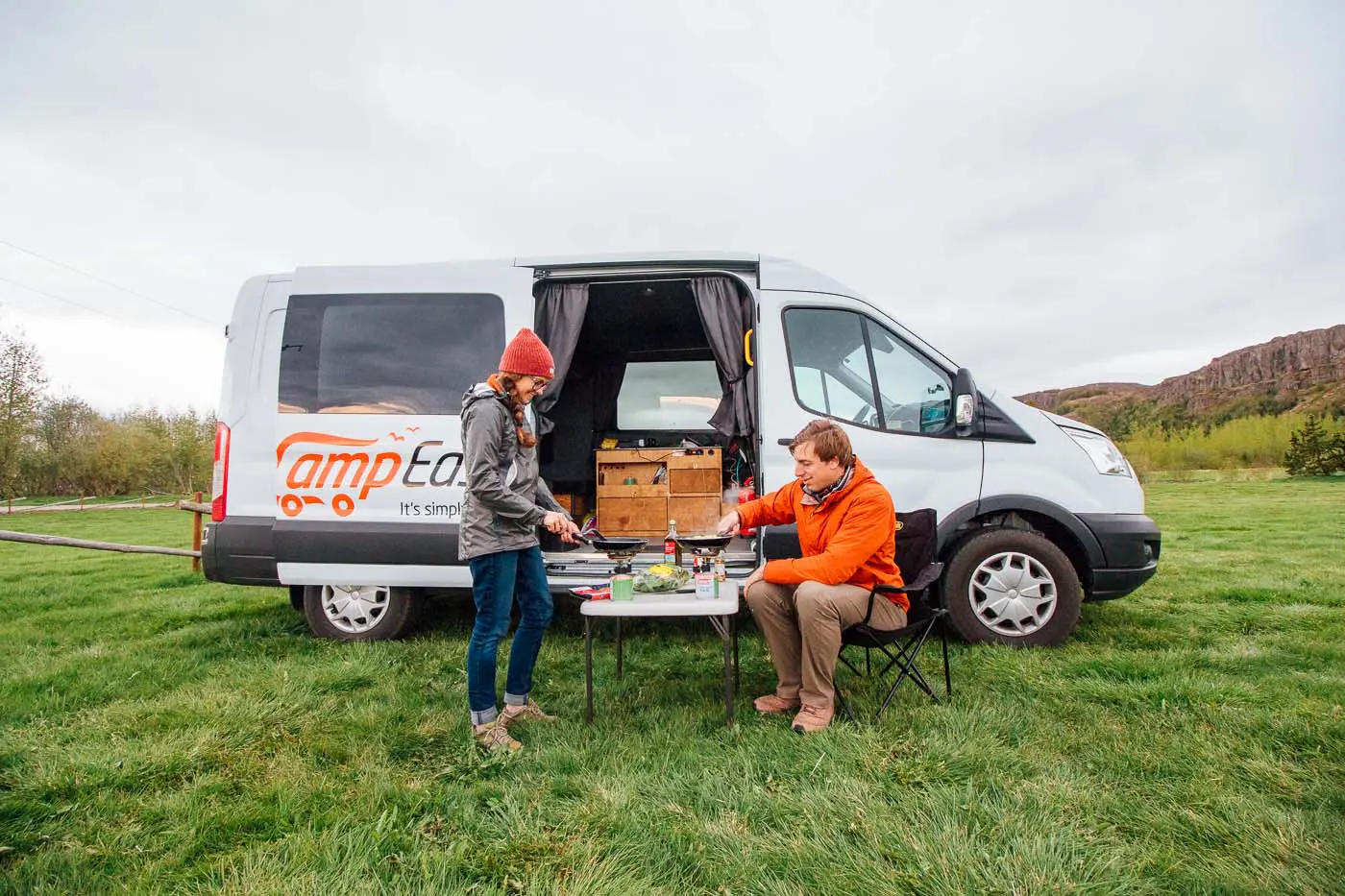
Keeping your devices charged
One of the biggest challenges of any road trip is keeping all of your multiple devices charged. Cameras, cell phones, laptops, tablets, anything with a rechargeable battery.
USB Charging: Inside your van rental you will have the ability to charge devices via USB. 12-volt power in Iceland is the same as 12-volt power in the US.
Inverter: If you need to charge a device using a standard US wall-power plug (like laptops or DSLR batteries) then you will need an inverter. You can either bring your own inverter or rent one from the van company. If you bring your own inverter from the US, it will inverter the 12-volt electricity up to 110-volt electricity (the same as in your house) and you will be able to plug right in. If you rent an inverter in Iceland, it will invert the 12-volt electricity up to 240 volts (the European standard) The shape of the receptacle is different than the US and you will need an adaptor.
Adaptors: In Iceland (and in much of mainland Europe) the standard plug is Type C. You can also use a Type E/F adaptor in Iceland as well. An adaptor just changes the shape of the plug; it does not change the voltage. So you will still be charging at 240 volts. Check your appliance to make sure it can handle 240-volt charging. Most modern laptops are designed to handle anywhere between 110-240 volt, but many smaller older devices may not. If your specific appliance requires 110 volts, then a special step-down transformer may be required.
Staying connected
When we rented our van from Camp Easy, we had the option to rent a WiFi hotspot. We went for the upgrade and it was one of the best decisions of the trip.
Can you do a road trip through Iceland using just a paper map? Absolutely, yes. A paper map is totally sufficient. But the WiFi hotspot allowed us to do so much more. The most important of which was that we could research on the fly.
Where did all these wild horses come from? What’s the wind forecast for tomorrow? How many people live in Iceland? Where is the best place to see puffins? When you’re on a long road trip, you can come up with a million different questions and with a WiFi hotspot, you can have the answers.
We could make voice-over-WiFi calls to our parents to let them know where we were. We could stream music and listen to podcasts. And of course, post to Instagram.
Coverage for the WiFi hotspot was excellent. We traversed the entire ring road with many, many detours along the way and only briefly lost service a couple of times.
